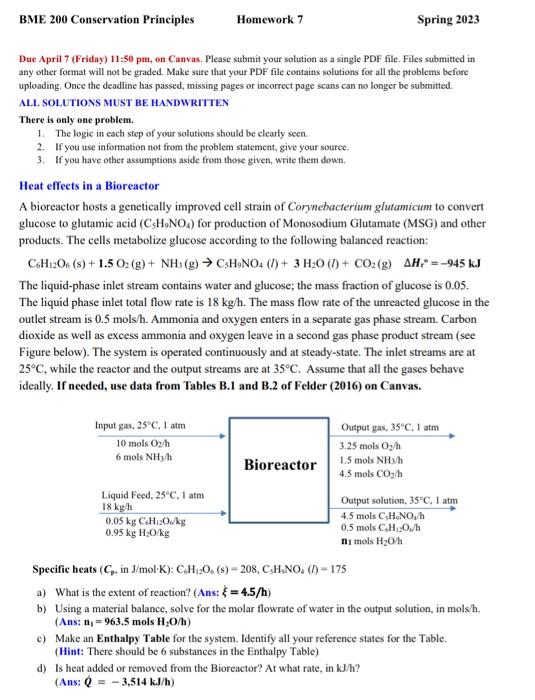Answered step by step
Verified Expert Solution
Question
1 Approved Answer
Due April 7 (Friday) 11:50 pm, on Canvas. Please submit your solution as a single PDF file. Files submitted in any other format will not
 Due April 7 (Friday) 11:50 pm, on Canvas. Please submit your solution as a single PDF file. Files submitted in any other format will not be graded. Make sure that your PDF file contains solutions for all the problems before uploading. Once the deadline has passed, missing pages or incorrect page scans can no longer be submitted. ALL. SOLUTIONS MUST BE HANDWRITTEN There is only one problem. 1. The logic in each step of your solutions should be clearly seen. 2. If you use information not from the problem statement, give your source. 3. If you have other assumptions aside from those given, write them down. Heat effects in a Bioreactor A bioreactor hosts a genetically improved cell strain of Corynebacterium glutamicum to convert glucose to glutamic acid (C5H9NO4) for production of Monosodium Glutamate (MSG) and other products. The cells metabolize glucose according to the following balanced reaction: C6H12O6(s)+1.5O2(g)+NH3(g)C5H9NO4(l)+3H2O(l)+CO2(g)Hr=945kJ The liquid-phase inlet stream contains water and glucose; the mass fraction of glucose is 0.05 . The liquid phase inlet total flow rate is 18kg/h. The mass flow rate of the unreacted glucose in the outlet stream is 0.5mols/h. Ammonia and oxygen enters in a separate gas phase stream. Carbon dioxide as well as excess ammonia and oxygen leave in a second gas phase product stream (see Figure below). The system is operated continuously and at steady-state. The inlet streams are at 25C, while the reactor and the output streams are at 35C. Assume that all the gases behave ideally. If needed, use data from Tables B.1 and B.2 of Felder (2016) on Canvas. Specific heats (Cp, in J/molK):C6H12O6(s)=208,C5H4NO4(l)=175 a) What is the extent of reaction? (Ans: =4.5/h ) b) Using a material balance, solve for the molar flowrate of water in the output solution, in mols/h. (Ans: n1=963.5 mols H2O/h ) c) Make an Enthalpy Table for the system. Identify all your reference states for the Table. (Hint: There should be 6 substances in the Enthalpy Table) d) Is heat added or removed from the Bioreactor? At what rate, in kJ/h ? (Ans: Q=3,514kJ/h )
Due April 7 (Friday) 11:50 pm, on Canvas. Please submit your solution as a single PDF file. Files submitted in any other format will not be graded. Make sure that your PDF file contains solutions for all the problems before uploading. Once the deadline has passed, missing pages or incorrect page scans can no longer be submitted. ALL. SOLUTIONS MUST BE HANDWRITTEN There is only one problem. 1. The logic in each step of your solutions should be clearly seen. 2. If you use information not from the problem statement, give your source. 3. If you have other assumptions aside from those given, write them down. Heat effects in a Bioreactor A bioreactor hosts a genetically improved cell strain of Corynebacterium glutamicum to convert glucose to glutamic acid (C5H9NO4) for production of Monosodium Glutamate (MSG) and other products. The cells metabolize glucose according to the following balanced reaction: C6H12O6(s)+1.5O2(g)+NH3(g)C5H9NO4(l)+3H2O(l)+CO2(g)Hr=945kJ The liquid-phase inlet stream contains water and glucose; the mass fraction of glucose is 0.05 . The liquid phase inlet total flow rate is 18kg/h. The mass flow rate of the unreacted glucose in the outlet stream is 0.5mols/h. Ammonia and oxygen enters in a separate gas phase stream. Carbon dioxide as well as excess ammonia and oxygen leave in a second gas phase product stream (see Figure below). The system is operated continuously and at steady-state. The inlet streams are at 25C, while the reactor and the output streams are at 35C. Assume that all the gases behave ideally. If needed, use data from Tables B.1 and B.2 of Felder (2016) on Canvas. Specific heats (Cp, in J/molK):C6H12O6(s)=208,C5H4NO4(l)=175 a) What is the extent of reaction? (Ans: =4.5/h ) b) Using a material balance, solve for the molar flowrate of water in the output solution, in mols/h. (Ans: n1=963.5 mols H2O/h ) c) Make an Enthalpy Table for the system. Identify all your reference states for the Table. (Hint: There should be 6 substances in the Enthalpy Table) d) Is heat added or removed from the Bioreactor? At what rate, in kJ/h ? (Ans: Q=3,514kJ/h )

Step by Step Solution
There are 3 Steps involved in it
Step: 1

Get Instant Access to Expert-Tailored Solutions
See step-by-step solutions with expert insights and AI powered tools for academic success
Step: 2

Step: 3

Ace Your Homework with AI
Get the answers you need in no time with our AI-driven, step-by-step assistance
Get Started


